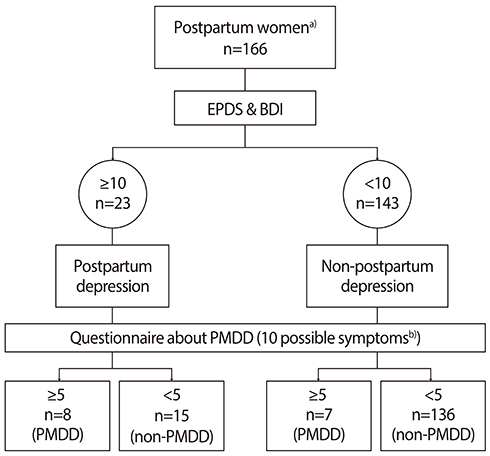Obstet Gynecol Sci.
2015 Sep;58(5):353-358. 10.5468/ogs.2015.58.5.353.
Correlation between postpartum depression and premenstrual dysphoric disorder: Single center study
- Affiliations
-
- 1Department of Obstetrics and Gynecology, Gangneung Asan Hospital, University of Ulsan College of Medicine, Gangneung, Korea. dhju@gnah.co.kr
- 2Department of Psychiatry, Gangneung Asan Hospital, University of Ulsan College of Medicine, Gangneung, Korea.
- KMID: 2058458
- DOI: http://doi.org/10.5468/ogs.2015.58.5.353
Abstract
OBJECTIVE
To describe the prevalence and correlates of the postpartum depression and premenstrual dysphoric disorder.
METHODS
One hundred sixty six women were assessed around 10th to 14th days after delivery in Gangneung Asan Hospital, Korea, from September 2011 to March 2012. We checked their risk factors for postpartum depressive disorders using the Beck Depression Inventory and the Edinburgh Postnatal Depression Scale. Premenstrual dysphoric disorder was evaluated retrospectively and was defined as having more than 5 of the following 10 symptoms: breast tenderness, bloating, headache, peripheral edema (hand and foot), depressive symptoms, anger, irritability, anxiety, oversensitivity, and exaggerated mood swings.
RESULTS
The prevalence rate of postpartum depression using the Edinburgh Postnatal Depression Scale > or =10 and Beck Depression Inventory > or =10 was 13.9% (23/166). We found statistical differences (P<0.01) between the postpartum depression group and the postpartum non-depression group in smoking history, past history of psychiatric problems, and level of marital satisfaction. The prevalence rate of premenstrual syndrome (PMS) was 9% (15/166) and among 23 women in the postpartum depression group, eight were determined to have premenstrual dysphoric disorder, yielding a prevalence rate of 34.8% (8/23). Among 143 women in the postpartum non-depression group, seven were determined to have PMS, yielding a prevalence rate of 4.9% (7/143). A correlation between postpartum depression and PMS was thus found (P<0.01).
CONCLUSION
PMS appears to be associated with postpartum depression. This means that a hormone-related etiology appears to be one risk factor for postpartum depression.
MeSH Terms
Figure
Reference
-
1. Kessler RC, McGonagle KA, Swartz M, Blazer DG, Nelson CB. Sex and depression in the National Comorbidity Survey. I: lifetime prevalence, chronicity and recurrence. J Affect Disord. 1993; 29:85–96.2. Weissman MM, Bland RC, Canino GJ, Faravelli C, Greenwald S, Hwu HG, et al. Cross-national epidemiology of major depression and bipolar disorder. JAMA. 1996; 276:293–299.3. Soares CN, Zitek B. Reproductive hormone sensitivity and risk for depression across the female life cycle: a continuum of vulnerability? J Psychiatry Neurosci. 2008; 33:331–343.4. Schmidt PJ, Nieman LK, Danaceau MA, Adams LF, Rubinow DR. Differential behavioral effects of gonadal steroids in women with and in those without premenstrual syndrome. N Engl J Med. 1998; 338:209–216.5. Bloch M, Schmidt PJ, Danaceau M, Murphy J, Nieman L, Rubinow DR. Effects of gonadal steroids in women with a history of postpartum depression. Am J Psychiatry. 2000; 157:924–930.6. Frank RT. The hormonal causes of premenstrual tension. Arch Neurol Psychiatry. 1931; 26:1053–1057.7. Berlin FS, Bergey GK, Money J. Periodic psychosis of puberty: a case report. Am J Psychiatry. 1982; 139:119–120.8. Lingjaerde P, Bredland R. Hyperestrogenic cyclic psychosis. Acta Psychiatr Neurol Scand. 1954; 29:355–364.9. Felthous AR, Robinson DB, Conroy RW. Prevention of recurrent menstrual psychosis by an oral contraceptive. Am J Psychiatry. 1980; 137:245–246.10. Kinch RA, Robinson GE. Premenstrual syndrome: current knowledge and new directions. Can J Psychiatry. 1985; 30:467–468.11. Johnson SR, McChesney C, Bean JA. Epidemiology of premenstrual symptoms in a nonclinical sample. I. Prevalence, natural history and help-seeking behavior. J Reprod Med. 1988; 33:340–346.12. Rivera-Tovar AD, Frank E. Late luteal phase dysphoric disorder in young women. Am J Psychiatry. 1990; 147:1634–1636.13. Bailey JW, Cohen LS. Prevalence of mood and anxiety disorders in women who seek treatment for premenstrual syndrome. J Womens Health Gend Based Med. 1999; 8:1181–1184.14. Cox JL, Holden JM, Sagovsky R. Detection of postnatal depression. Development of the 10-item Edinburgh Postnatal Depression Scale. Br J Psychiatry. 1987; 150:782–786.15. Beck AT, Ward CH, Mendelson M, Mock J, Erbaugh J. An inventory for measuring depression. Arch Gen Psychiatry. 1961; 4:561–571.16. American College of Obstetricians and Gynecologists. Premenstrual syndrome. Washington, DC: American College of Obstetricians and Gynecologists;2000.17. American Psychiatric Association. Diagnostic and statistical manual of mental disorders: DSM-IV-TR. Washington, DC: American Psychiatric Association;2000.18. Choi D, Lee DY, Lehert P, Lee IS, Kim SH, Dennerstein L. The impact of premenstrual symptoms on activities of daily life in Korean women. J Psychosom Obstet Gynaecol. 2010; 31:10–15.19. Hong JP, Park S, Wang HR, Chang SM, Sohn JH, Jeon HJ, et al. Prevalence, correlates, comorbidities, and suicidal tendencies of premenstrual dysphoric disorder in a nationwide sample of Korean women. Soc Psychiatry Psychiatr Epidemiol. 2012; 47:1937–1945.20. Gregory RJ, Masand PS, Yohai NH. Depression across the reproductive life cycle: correlations between events. Prim Care Companion J Clin Psychiatry. 2000; 2:127–129.21. Chung SH, Kim TH, Lee HH, Lee A, Jeon DS, Park J, et al. Premenstrual syndrome and premenstrual dysphoric disorder in perimenopausal women. J Menopausal Med. 2014; 20:69–74.22. Perez-Stable EJ, Marin G, Marin BV, Katz MH. Depressive symptoms and cigarette smoking among Latinos in San Francisco. Am J Public Health. 1990; 80:1500–1502.23. Brown RA, Lewinsohn PM, Seeley JR, Wagner EF. Cigarette smoking, major depression, and other psychiatric disorders among adolescents. J Am Acad Child Adolesc Psychiatry. 1996; 35:1602–1610.
- Full Text Links
- Actions
-
Cited
- CITED
-
- Close
- Share
- Similar articles
-
- The Standardization of the Shortened Premenstrual Assessment Form and Applicability on the Internet
- Prevalence of Premenstrual Dysphoric Disorder and Occupational Function in a Nurse Group
- Understanding and Treatment of Premenstrual Dysphoric Disorder
- Relationship among Cognitive Style, Perceived Stress and Premenstrual Symptoms
- Premenstrual syndrome & premenstrual dysphoric disorder


